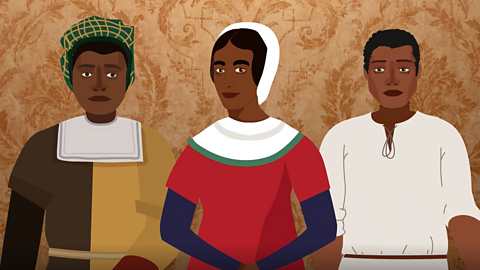Key points
- Henry VIII was a Tudor king who ruled England from 1509 - 1547. He is remembered for his six wives and his cruelty towards them.
- Henry VIII sought to achieve military success and bring greatness to his kingdom.
- One of the most significant events of his reign, which had a long lasting impact, was his decision to break with the Catholic Church and establish the Church of England.
Game - Henry VIII
Play a History Detectives mission exploring whether Henry VIII was a bad husband.
You can also play the full game.
Activity - who are you at the court of Henry VIII?
The Tudor Family
Henry VIIIтs father, Henry VII, was the founder of the Tudor dynasty. He took the throne in 1485.
During Henry VIIтs lifetime, two branches of the English royal family fell into conflict with one another. They were fighting over who should take the English throne. This period is known as the Wars of the RosesA conflict between the houses of Lancaster and York, which lasted from 1455 to 1487. The two sides were rival claimants to the English throne. . Henry VII became king towards the end of the Wars of the Roses.
Henry VII married Elizabeth of York and had a large family with her. Henry VII was succeeded by his son, Henry VIII, and then by his grandchildren, Edward VI, Mary I and Elizabeth I. The Tudors ruled from 1485 to 1603.
What were the Wars of the Roses?
The Wars of the Roses were a series of civil wars that were fought over the right to the English throne. The conflict was between the House of York and the House of Lancaster; it began in 1455 and lasted a little over 30 years. The House of Lancaster was represented by a red rose, and York by a white rose. Henry VII was distantly related to the royal House of Lancaster.
In 1455, Richard, Duke of York, took King Henry VI captive during a battle, and was appointed Lord Protector by Parliament. After around 4 years of relative peace, the fighting resumed, and many more battles took place. In 1485, the Lancastrian Henry Tudor won the throne from the Yorkist Richard III at the Battle of Bosworth Field. While some have seen this as the end of the conflict, other historians have suggested that the Battle of Stoke Field, which was fought between Yorkists and Lancastrians in 1487, was the actual end of the fighting between the two houses.
Who was the young Henry VIII?
The future Henry VIII was the second son of Henry VII. This meant that Henryтs older brother Prince Arthur was raised as a future ruler, because it was expected that, as the eldest, he would be king. Prince Henry was brought up in a separate palace, alongside his mother and sisters.
Prince Henry was a very clever child. He was a good musician, enjoyed joustingIn full armour, men charged at each other on horseback, each seeking to knock the other off their horse., and, like many royals, spoke several languages. His learning earned him the praise of one of the most well-known thinkers of the time, Erasmus, who was a Dutch scholar and philosopher. Erasmus found Henry to be very well educated and regal in his behaviour, even though the prince was only nine years old when they met.
In 1502, Henryтs brother Arthur died, followed a year later by their mother, Elizabeth of York. Following their deaths, Henry was made to live with his father. This was difficult for the young Henry. We know that, during these years, the prince rarely appeared in public and was supervised constantly.
Following the death of his father in 1509, Henry VIII became King of England. He had big ambitions. He quickly set about establishing a glittering court with his new wife, Catherine of Aragon, who had previously been married to his older brother, Arthur.
What was the young Henry VIII's court like?
The court is a name given to the group of people who were members of the monarchтs household. Courtiers, as they were known, were noble men and women who served the king and queen, and also supported the monarch in running the country.
The court lived in the palace alongside Henry. Henry owned many palaces, and every couple of weeks the court would move to a new palace while the last was cleaned.
The young Henry VIII wanted to create a magnificent court. He and his wife Catherine wore fine clothes, employed talented musicians and threw elaborate jousts and parties.
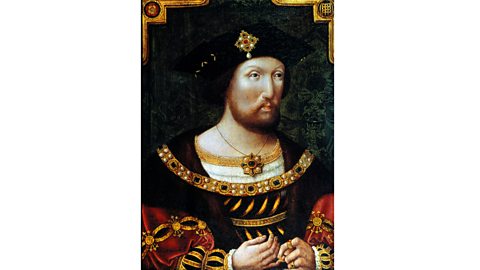
Henry VIII's foreign policy
Henry wanted to be like a previous king of England, Henry V, and conquer France.
Henryтs initial invasion of France, in 1512, was a failure. He had been promised support by his father-in-law, Ferdinand II of Aragon. The support never arrived, and many of Henryтs troops became ill while waiting.
A second invasion, in 1513, saw Henryтs army defeat a band of French soldiers at the Battle of the Spurs. They also took the towns of ThУЉrouanne and Tournai. Henry commissioned large paintings of this campaign, which can be seen today at Hampton Court Palace.
Henryтs wars with France continued throughout his reign. He also fought wars against Scotland, which was a traditional enemy of England, and Franceтs ally. Henryтs successive wars were very expensive, and he became desperate for more money. He fell into debt, and needed to raise more and more taxesMoney charged to the people of the kingdom by the monarch to fund various expenses, including raising money for wars and defence. .
As well as fighting in France, Henry also wanted to increase Englandтs reputation in Europe as a peacemaker. The king thought that one way to do this was to try to bring the royal families of Europe together. Alongside his ministerAn important servant of the king, whose job was to help with the running of the kingdom., Cardinal Thomas Wolsey, he organised peace summits between these royal families. One of the most famous of these summits was the Field of Cloth of Gold.
What was the Field of the Cloth of Gold?
In 1520, the Field of Cloth of Gold was a meeting to establish peace between England and France following Henry's invasions. However, it had the opposite effect. Instead, it became an opportunity for the rival kings, Henry VIII and Francis I, to show off their wealth and power.
A temporary city with palaces and over 2,000 tents was constructed for the event. Henry's court used twenty-seven ships to get to France, and tensions rose when Francis overpowered Henry to win a wrestling match. Henry invaded France once again in 1522, and he went to war with France several more times over the course of his reign.
Activity - the Field of the Cloth of Gold
Religion
Like many people during Tudor times, Henry VIII believed that men should rule the country. He wanted a son to reign after his death, but he and his first wife's only surviving child was a daughter, Mary.
In the 1520s, Henry attempted to have his marriage annulmentA way of ending a marriage that is different from a divorce. It could be granted by the Catholic Church, and meant that a marriage never legally existed. by the . He claimed that marrying his brotherтs widow had left him childless, despite the fact that he had a daughter. Henry believed that the Bible verse that inspired his views meant тsonlessт.
The Pope allowed Henry to put his marriage on trial in England. The Pope sent a representative, Cardinal Campeggio, to help give a judgment on the marriage. After months of deliberations, the Pope refused to grant Henry his annulment.
Henry was disappointed and still wanted a male heir. He was inspired by Protestantism A form of Christianity that originated in the early 16th century, after a German priest, Martin Luther, published a long list of criticisms of the Catholic Church. books that questioned the power of the Pope, as well as reform-minded men and women at court who had read these books and were supportive of many of their ideas.
Henry he was eager to act. He formally married Anne in January 1533 and then created the Church of England. With the help of his ministers and ParliamentElected members of the House of Commons, and the House of Lords, who helped the King to pass laws., Henry made himself, not the Pope, the head of the English Church.
For more information about why the Pope refused to grant Henry his annulment, and the consequences of this decision, read our guide on the Reformation.
Game - Henry and the Catholic Church
Play a History Detectives mission exploring why Henry split from the Catholic Church.
You can also play the full game.
Government under Henry VIII
There is still much debate among historians about how Henry VIII governed the country and the amount of power he allowed his ministers and advisors.
At the start of his reign, Henry would spend his days hunting, jousting and attending parties. He wrote a song about his lifestyle, called Pastyme with Good Companye. He would spend some time on the running of the country after Mass each day.At the start of Henry VIIIтs reign, a council advised the young king. Henry then began to rely on key men such as Thomas Wolsey and Thomas Cromwell. They were known as ministers, and they helped Henry with the day-to-day running of the country.
Although he had Wolsey and Cromwell to assist him, Henry still had the final say. When his ministers failed him, they faced real danger. Wolsey died on his way to prison, after failing to get Henry his divorce from Catherine of Aragon. Cromwell was beheaded in 1540, having been declared a traitor. The list of charges brought against Cromwell was long and mostly focused on his support of religious radicals, though Henryтs failed marriage to Anne of Cleves, which was encouraged by Cromwell, could also have played a role. The downfall of both men came about because Henry was prepared to listen to their enemies at court.
As a result of the Reformation, Henry gained more power. Firstly, he became the Supreme Head of the Church of England, which was significant as so many people throughout the country were deeply religious. Secondly, he began to use Parliament to get what he wanted. In 1539, Henry passed an act called the Statute of Proclamations, which allowed him to make changes to how England was run simply by reading out orders instead of passing laws in the traditional way.
Marriages and children
Henry VIII is famous for having six wives, three of whom gave birth to heirs to the throne. Henry was cruel to his wives. This inspired the rhyme about their fates: тdivorced, beheaded, died, divorced, beheaded, survivedт.
Scroll through the slides to learn more about these queens.
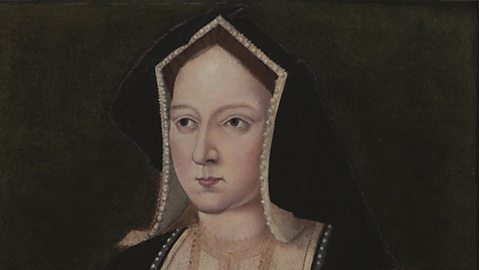
Image caption, Catherine of Aragon was a Spanish princess, the daughter of King Ferdinand and Queen Isabella. They had raised Catherine to be the future Queen of England. In 1502, she married Henry's older brother, Prince Arthur, following a long voyage from Spain. After Arthur's death, Catherine was stranded in England. She married Henry in 1509, and was his wife for 24 years. Though she became pregnant numerous times, only one child, Mary, survived. Catherine remained convinced that she was the true English queen until her death, in 1536.
Image caption, Anne Boleyn spent her youth in France, at the court of Francis I. She returned to England in the 1520s, and met Henry when she became a member of his court. Anne was witty and well educated. She did not hesitate to air her views, and publicly declared her frustration about the delays to Henry's divorce from Catherine. She even once shouted at Henry before the court, because she was upset that he had accepted gifts from Catherine. Anne became queen in 1533, giving birth to a daughter, Elizabeth, in the same year. In 1536, Anne was executed on charges of treason and adultery, which were probably false. She was executed along with five men, including her brother.
Image caption, Jane Seymour had been a lady-in-waiting to Anne Boleyn. Jane was not as highly educated as Catherine or Anne, though she was exceptionally talented at needlework. Henry began to take an interest in Jane when Anne was still alive. Jane and Henry were married 11 days after Anne's execution, in May 1536. Henry was desperate for a male heir, and in October 1537 Jane gave birth to a son, Edward. Jane died shortly after the birth of her son, following complications arising from childbirth. When Henry died in 1547, he was buried alongside Jane.
Image caption, Anne of Cleves was a member of the German nobility. The Cleves family were Protestant, and many people felt that they would make good allies for Henry following his break from the Catholic Church. Anne and Henry's marriage proved to be a disaster. Henry burst into Anne's rooms in disguise to surprise her before they got married. Anne did not recognise him, and was shocked, which left Henry feeling insulted. The wedding went ahead, but Henry quickly sought an annulment. He said openly that Anne was unattractive, though she probably wasn't, and that he'd been tricked into the marriage. Anne was given the title of 'King's Beloved Sister', to show that she was an honorary member of the royal family, as well as her own houses. She became very wealthy.
Image caption, Catherine Howard was a cousin of Anne Boleyn. She was a teenager when she married Henry, who was 49. Some sources have described Catherine as joyful and carefree, and she apparently enjoyed dressing in fashionable clothes that were decorated with many jewels. When Henry found out that Catherine was in a secret relationship with Thomas Culpeper, in November 1541, he had her arrested. She was executed for treason and adultery, just like her cousin.
Image caption, Catherine Parr was Henry's last wife. By the time they were married, Henry was in his fifties and suffering from an unhealed and infected wound from a jousting accident. He was in pain and struggled to walk. Catherine was intelligent and well-read. She was a religious reformer and a skilled writer, publishing works on religion. Catherine became close to Henry's daughter, Elizabeth, inspiring the young princess to write her own translations, into Latin, of Catherine's work. Despite Catherine's devotion to Henry, she was almost arrested for her religious beliefs. Catherine survived Henry, who died in January 1547.
1 of 6
Game - Henry's marriages
Play a History Detectives mission exploring whether Henry VIII remarried in order to have a male heir.
You can also play the full game.
Test your knowledge
Play the History Detectives game! gamePlay the History Detectives game!
Analyse and evaluate evidence to uncover some of historyтs burning questions in this game.

More on The Tudors
Find out more by working through a topic
- count2 of 5
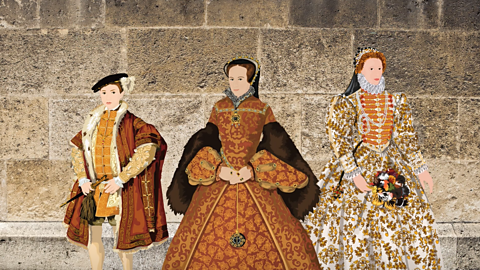
- count3 of 5
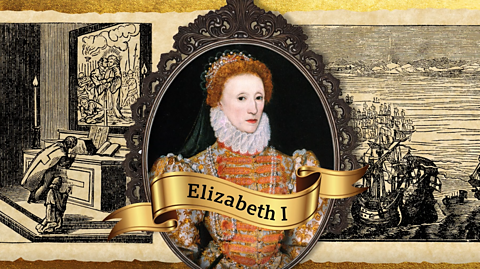
- count4 of 5
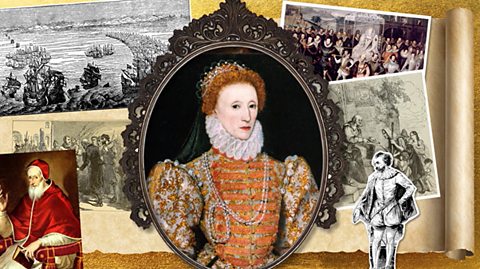
- count5 of 5
